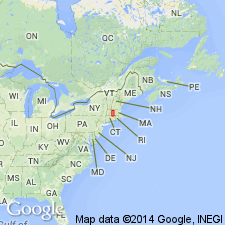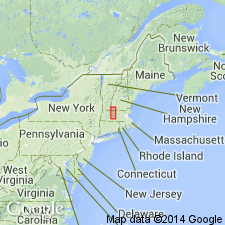
- Usage in publication:
-
- Dry Hill Gneiss*
- Modifications:
-
- Overview
- AAPG geologic province:
-
- New England province
Summary:
Used as Dry Hill Gneiss of Proterozoic Z age. Subdivided into a gneiss and quartzite unit, a schist and quartzite unit, and Pelham Quartzite Member. Mapped undivided with Poplar Mountain Gneiss in places.
Source: GNU records (USGS DDS-6; Reston GNULEX).

- Usage in publication:
-
- Dry Hill Gneiss*
- Modifications:
-
- Age modified
- Revised
- Overview
- AAPG geologic province:
-
- New England province
Summary:
Was originally described by Balk (1956) to include most felsic gneisses in Pelham dome except for those described by him as Poplar Mountain Gneiss. Previously called Becket Gneiss (Emerson, 1898) or Pelham Granite (Emerson, 1917). Redefined by Ashenden (1973) to include most of Balk's Dry Hill Gneiss except for those rocks assigned by Balk to so-called border facies. Ashenden (1973) showed that border facies is completely different from the felsic gneisses and assigned it to Fourmile Gneiss. Dry Hill is considered to be a series of metamorphosed rhyolitic tuffs (Ashenden, 1973; Hodgkins, 1983) with minor intercalated layers of sedimentary derivation. Dry Hill Gneiss revised to include Pelham Quartzite Member (rank reduced) which occurs outside of Ashenden's (1973) study area. The informal Rocky Run gneiss, which was applied to the portion of Dry Hill Gneiss stratigraphically above Pelham Quartzite, is dropped from usage. Age of Dry Hill Gneiss is changed from late Precambrian to Late Proterozoic.
Source: GNU records (USGS DDS-6; Reston GNULEX).

- Usage in publication:
-
- Dry Hill Gneiss
- Modifications:
-
- Geochronologic dating
- AAPG geologic province:
-
- New England province
Summary:
Microcline gneiss of the Dry Hill Gneiss in the Pelham dome, a metamorphosed alkali rhyolite, is confirmed to be Late Proterozoic with an age of 613+/-3 Ma.
Source: GNU records (USGS DDS-6; Reston GNULEX).
For more information, please contact Nancy Stamm, Geologic Names Committee Secretary.
Asterisk (*) indicates published by U.S. Geological Survey authors.
"No current usage" (†) implies that a name has been abandoned or has fallen into disuse. Former usage and, if known, replacement name given in parentheses ( ).
Slash (/) indicates name conflicts with nomenclatural guidelines (CSN, 1933; ACSN, 1961, 1970; NACSN, 1983, 2005, 2021). May be explained within brackets ([ ]).

